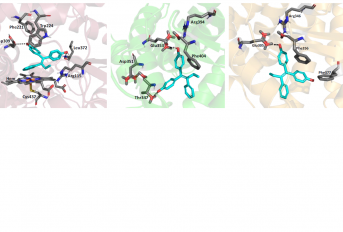Associação Portuguesa de Investigação em Cancro
Discovery of a multi-target compound for the treatment of breast cancer ER+
Discovery of a multi-target compound for the treatment of breast cancer ER+

Authors and Affiliations:
Cristina Ferreira Almeida1, Natércia Teixeira1, Ana Oliveira2, Tiago V. Augusto1, Georgina Correia-da-Silva1, Maria João Ramos2, Pedro Alexandrino Fernandes2, Cristina Amaral1
1 UCIBIO.REQUIMTE, Laboratory of Biochemistry, Department of Biological Sciences, Faculty of Pharmacy, University of Porto, Rua Jorge Viterbo Ferreira, n° 228, 4050-313 Porto, Portugal
2 LAQV.REQUIMTE, Computational Biochemistry Group, Department of Chemistry and Biochemistry, Faculty of Sciences, University of Porto, Rua do Campo Alegre, s/n, 4169-007 Porto, Portugal
Abstract:
Despite intense research, breast cancer remains the leading cause of cancer-related death in women worldwide, being estrogen receptor-positive (ER+) the most common subtype. Nowadays, aromatase inhibitors (AIs), the selective estrogen receptor modulator (SERM) tamoxifen and the selective estrogen receptor down-regulator (SERD) fulvestrant are used as therapeutic options for ER+ breast cancer, since they interfere directly with the production of estrogens and with the activation of estrogen-dependent signaling pathways. Despite the success of these treatments, the occurrence of resistance limits their clinical efficacy, demanding the development of novel therapies. Recently, multi-target compounds emerged as promising therapeutic strategies for ER+ breast cancer, as they can potentially modulate several important targets simultaneously. In line with this, in this work, the anti-cancer properties and multi-target action of 1,1-Bis(4-hydroxyphenyl)-2-phenylbut-1-ene, tamoxifen bisphenol (1,1-BHPE), were evaluated in an ER+ breast cancer cell model (MCF-7aro cells). Molecular docking analysis predicted that 1,1-BHPE was able to bind to aromatase, ERα and ERβ. In vitro studies showed that, although it did not present anti-aromatase activity, 1,1-BHPE reduced aromatase protein levels and interfered with ERα and ERβ signaling pathways, acting as an ERα antagonist and inducing ERβ up-regulation. Through these mechanisms, 1,1-BHPE was able to impair breast cancer growth and induce apoptosis. This represents an important therapeutic advantage because the main players responsible for estrogen production and signaling are modulated by a single compound. To the best of our knowledge, this is the first study describing the anti-cancer properties of 1,1-BHPE as a multi-target compound specific for ER+ breast cancer.
Journal: Biochimie




